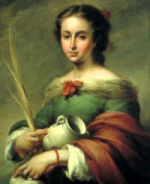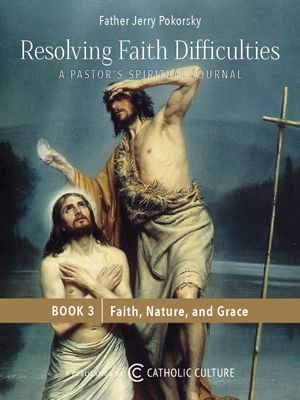The MOST Theological Collection: Vatican II: Marian Council
"Chapter 7 - Model of the Church"
To live out the implications of the ideal that flows with such logic from the doctrinal picture painted by Vatican II, we would begin by imitating the qualities of Mary. With this in mind, Vatican II presents her as the "Type of the Church." That word "Type" is used in two closely related senses: She is the prophecy-in-action of what the Church was to become, and still has not fully attained; she is the model for the Church, for the Church as a whole, and for each member of the Church.
To understand what a type means, we need to go back to the Old Testament and to the interpretations of it given by the early Fathers of the Church. The Fathers saw two kinds of prophecies in the Old Testament: prophecies made in words, and prophecies made by actions, or by the very existence of persons or things.
We need not delay on prophecies in words: everyone is familiar with that category. But the prophecies made by actions, which are types, need a bit of explanation. The situation is most easily seen through a few examples. Isaac, carrying the wood on which he himself was to be sacrificed, is a type of Christ carrying His cross. The ark, holding all who were saved from the deluge, is a type of the Church, which is the means of salvation from the waters of eternal destruction.
Somewhat similarly, the Council can speak of Mary as a Type of the Church:1 "The Mother of God is a Type of the Church, as St. Ambrose already taught, that is, [she is a Type] in the order of faith. love, and perfect union with Christ."
Mary is a Type who foretold what the Church was to be in two chief respects: she is both virgin and Mother. So too is the Church:2 "By believing and obeying, she begot the very Son of the Father on earth. She did not know man, but was overshadowed by the Holy Spirit, and, as the New Eve, she put her doubt-free faith in the messenger of God, not in the ancient serpent. She brought forth a Son whom God made the first-born3 among many brothers, that is, the faithful, in whose birth and development she cooperates with a motherly love."
The Council continues, showing how the Church follows after the Type or pattern of Mary in both respects. Mary was the Virgin who became a Mother by her faith; so too the Church:4 "Now the Church, contemplating her hidden holiness and imitating her love, and faithfully carrying out the will of the Father, likewise becomes a Mother by faithfully receiving the Word of God."
We note the fruitful play on the expression "receiving the Word of God." Mary received the Word of God in two senses: she received the words of the angel and obeyed them; she thereby conceived the Divine Word, that is, the second Person of the Most Blessed Trinity.
Similarly the Church:5 "by her preaching and by baptism, she [the Church] brings forth to new life Sons, conceived of the Holy Spirit, and born of God. And she too is a virgin, who keeps wholly and purely the fidelity she has pledged to her Spouse [the Holy Spirit], and, in imitating the Mother of her Lord, by the power of the Holy Spirit, in a virginal fashion keeps integral faith, solid hope, sincere love [for Him]."
However, in the case of Old Testament types, that which came first was less perfect than the later fulfillment. But when the Councll calls Mary the Type of the Church it openly proclaims that the Church falls short of its type6 "In the Blessed Virgin, the Church has already reached that perfection in which she is7 'without spot or wrinkle'. But the faithful are still struggling to grow in holiness by overcoming sin. And so they lift up their eyes to Mary, who shines forth to the whole community of the elect as the model of virtues."
In speaking of the perfect holiness of the Church, we need to distinguish two senses in which we could use the word Church. If we think of the Church in an almost abstract way, as the means established by Christ to bring men to holiness, a means that in itself possesses all power of sanctification, in that sense we can see the Church is already fully holy. But we can also, and more often do, think of the Church more concretely, as the totality of the Members of Christ the Head. The Council in the statement we have just read is thinking of the Church in this second way. Speaking within this category, we must, of course, recognize that no member or group of members of the Church ever has or ever will reach the perfection of holiness and love that Mary has already attained. We think spontaneously of the brilliant words of Pius IX. Because the Eternal Father planned to make her the Mother of His only Son, says the Pope,8 "He marvelously heaped upon her, more than on all angelic spirits and all the Saints, an abundance of all heavenly favours taken from the treasury of the divinity, so that she, always absolutely free from every stain of sin, and entirely beautiful and perfect, showed forth such a fulness of innocence and holiness that none greater under God can be thought of, and no one but God can comprehend it."
In no possible sense could the Church hope to attain so dazzling a height that only God Himself can know fully what it is!
No wonder then that the Council adds:9 "The Church, devoutly thinking on her, and contemplating her in the light of the Word-made-man, reverently enters more deeply into the supreme mystery of the incarnation, and is made more and more conformed to her Spouse... The Church, following after the glory of Christ, is made more like to her exalted Type, constantly advancing in faith, hope and love, and seeking and carrying out the divine will in all things."
We might have thought the Council would be content with its long and beautiful presentation of Mary as the model of the Church. But no, what it said in a general way for the whole Church, it wanted to restate individually for each of the chief groups within the Church.
To those engaged in the lay apostolate, the Council says:10 "The perfect model of this spiritual and apostolic life is the Most Blessed Virgin Mary, the Queen of Apostles, who, while she lived on earth the life common to all, filled with labours and care of her family, was always most closely joined with her Son, and cooperated in the work of the Saviour in an entirely singular way. Moreover now, assumed into heaven11 'by her motherly love she takes care of the brothers of her Son who are still on the way [to their eternal home] and who are involved in dangers and difficulties, until they are led to the blessed Fatherland.' Let all most devoutly honour her, and commend their life and apostolate to her motherly care."
Missionaries are urged to look upon her as the Queen of Apostles:12 "Realizing that it is God who brings it about that His Kingdom comes on earth, let them [missionaries] pour forth their prayers together with all the faithful, that through the intercession of the Virgin Mary, Queen of Apostles, the nations may be led as soon as possible to the knowledge of the truth..."
As if in special insistence, the Council twice, in two different documents, urges religious to follow Mary:13 "... the [evangelical] counsels ... contribute more than a little to spiritual freedom, they continually arouse the fervour of love, and especially, they are able to make the Christian person more and more conformed to the virginal way of life in poverty which Christ the Lord chose for Himself and which His Virgin Mother embraced..."14 "And so, by the prayers of the most sweet Virgin Mary Mother of God15 'whose life is the instruction of all,' may they daily make progress, and bring further richer salutary fruits."
Seminarians are on the way to becoming Priests, who are called "other Christs". Precisely because he is another Christ, the Priest is in a more special way a son of the Mother of Christ. To Seminarians the Council says:16 "Let them honour and love with the confidence of sons, the Most Blessed Virgin Mary, who was given as a Mother to the disciple by Christ Jesus as He died on the cross."
To Priests themselves the Council repeats the same advice:17 "They will always find a marvelous model of such docility [to the Holy Spirit] in the Blessed Virgin Mary who, led by the Holy Spirit, devoted herself totally to the mystery of the Redemption of men. Let priests love and honour with the devotion of sons, this Mother of the Eternal High Priest, the Queen of Apostles, and the protector of their ministry."
Finally, in the document renewing the liturgy, the Council added:18 "In celebrating this annual cycle of the Mysteries of Christ, Holy Church venerates the Blessed Mary, the Mother of God, with special love, she who is bound in an indissoluble bond with her Son in the work of Salvation. In her she admires and praises the most splendid fruit of the Redemption, and, as in a most pure image, contemplates that which she herself desires and joyfully hopes to be. "Meanwhile", as the Council said in its Constitution on the Church,19 "just as the Mother of Jesus, already glorified in body and soul in heaven, is the image, and the beginning of the Church-to-be-perfected in the world to come, so on earth until the day of the Lord comes, she [Mary] shines forth as a sure sign of hope and consolation to the People of God still on the way [to the heavenly fatherland].






